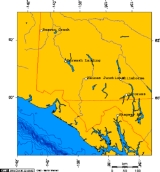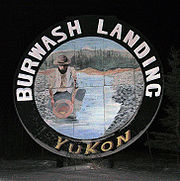
Burwash Landing, Yukon
Encyclopedia
Tourism

Kluane National Park and Reserve
Kluane National Park and Reserve are two units of Canada's national park system, located in the extreme southwestern corner of Yukon Territory. Kluane National Park Reserve was established in 1972, covering 22,016 square kilometres....
are also available out of Burwash Landing. Boat rentals and guided fishing trips on Kluane Lake are available locally. Canoeists may make a one-day float trip down the Kluane Lake to mouth of Kluane River to Kluane Wilderness village (25 mi (40.2 km)) from Burwash Landing. Beware of high winds on Kluane Lake. Wildlife on the Kluane River includes bears, wolves and eagles.
Southern Tutchone people
Burwash landing is the traditional home of the Southern Tutchone Athabascans. It used to be a summer camp. A revival of the Southern Tutchone language and culture has been taking place in this quiet lakeside community. This is readily apparent to visitors when they pull into town and are met with Southern Tutchone street and traffic signs, within and nearby Burwash Landing. Several prominent geographic features have been renamed in Southern Tutchone and signs can be seen along the Alaska (Alcan) Highway.Burls
Burwash Landing is known for its black spruce burlBurl
A burl or bur or burr is a tree growth in which the grain has grown in a deformed manner. It is commonly found in the form of a rounded outgrowth on a tree trunk or branch that is filled with small knots from dormant buds.A burl results from a tree undergoing some form of stress. It may be caused...
s. Burls start as an irritation in the spruce. The tree sends extra sap as healant, which creates a growth (burl). Burls are either "green," harvested from live trees in the spring, or they are "dry burls," taken from dead burl trees.Burls are peeled off their bark and used in their natural form as fenceposts, for example, or they may be shaped and finished into a variety of objects, such as bowls. Check the Burlbilly Hill on the Milepost 1061.6, the visitor will see rows of "burly logs" on the hill.
External links
- Burwash Landing and Destruction Bay at the Government of Yukon
- tourist info
- Kluane First Nation

